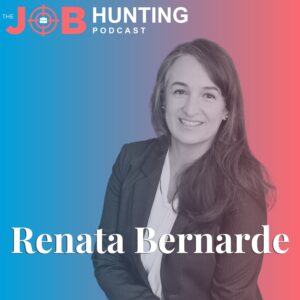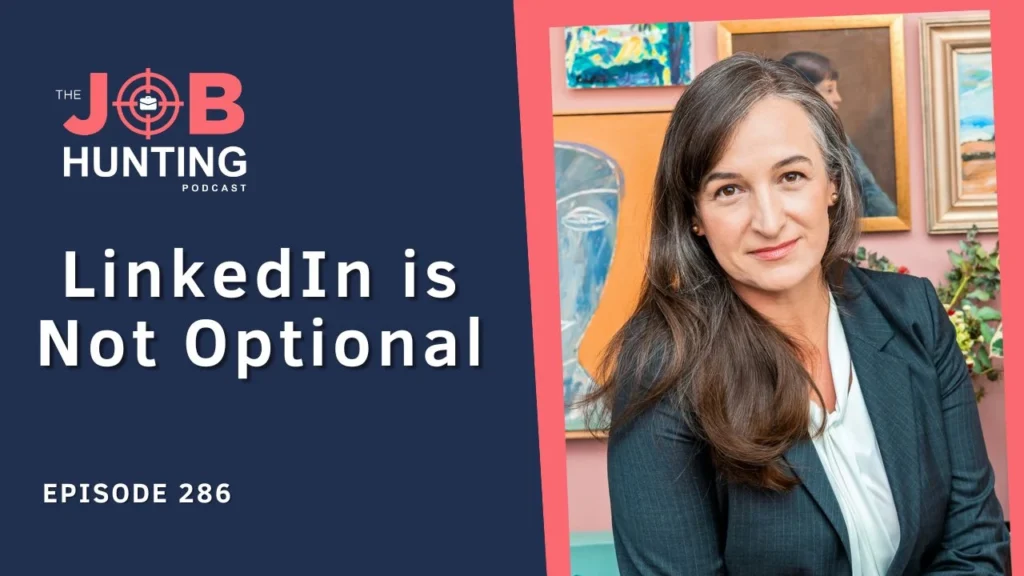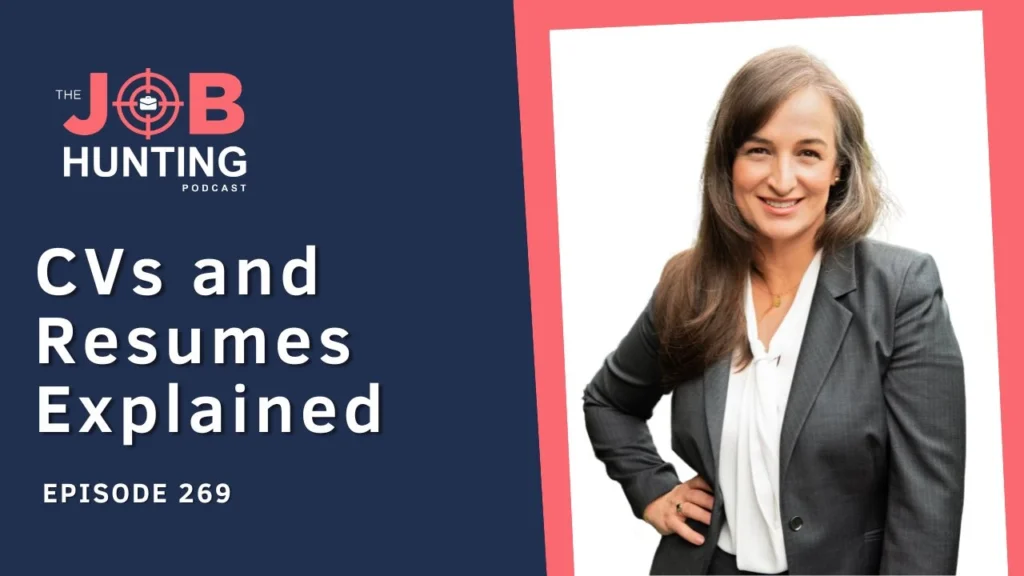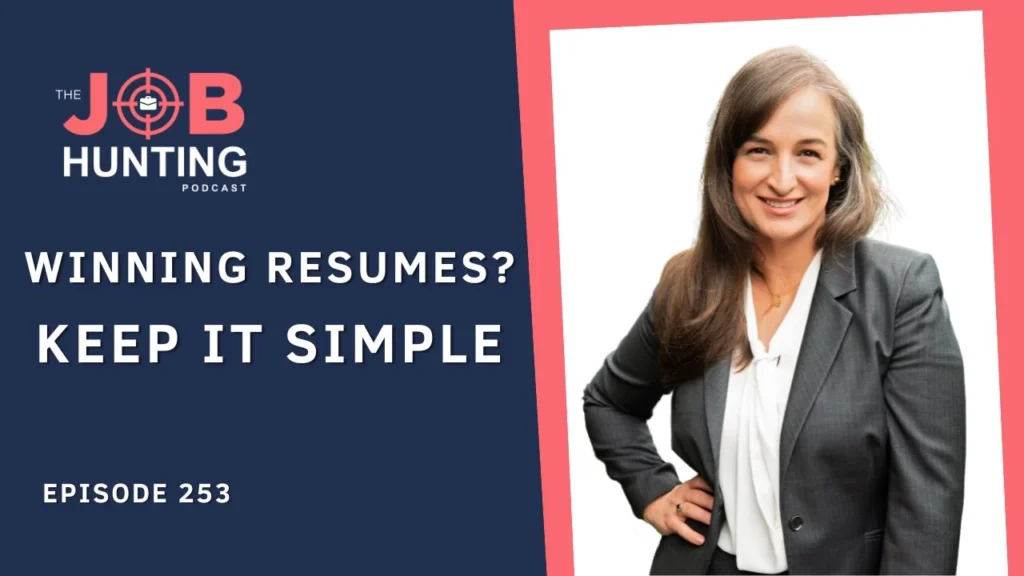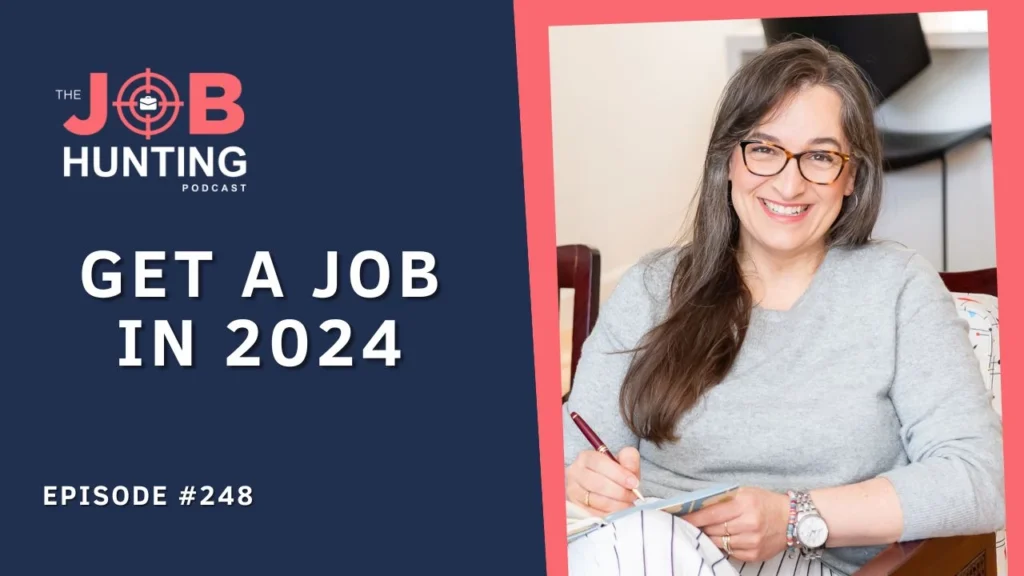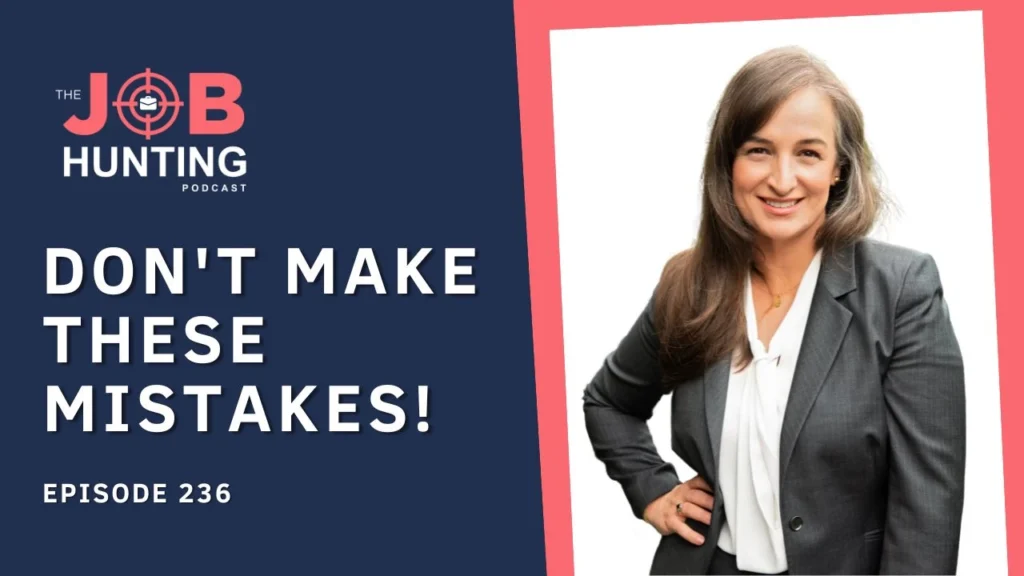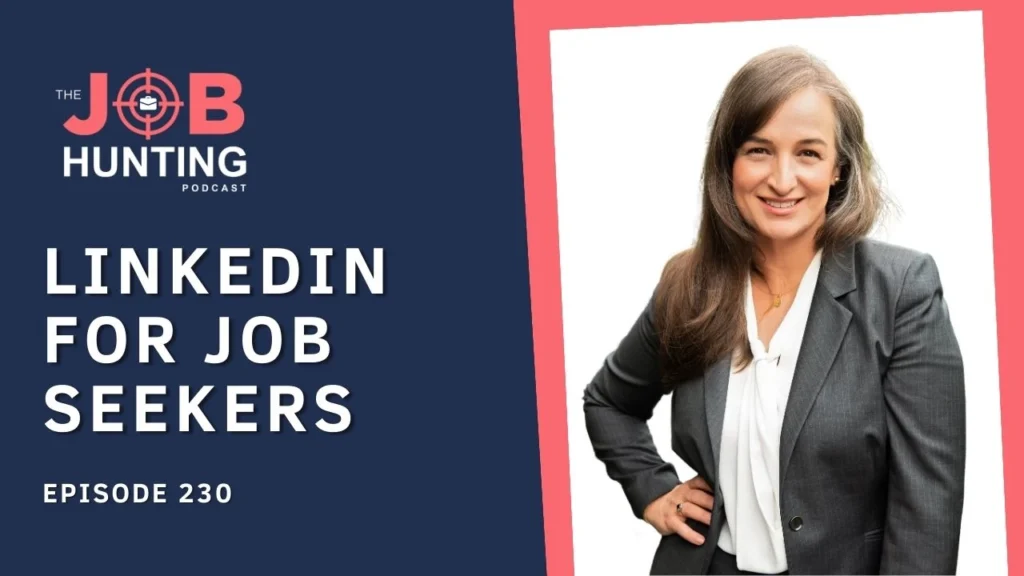Renata: Hello, and welcome to episode 101 of The Job Hunting Podcast. Today, we’re going to talk about what an executive resume should look like. This is an interesting topic. I’m sure a lot of you will benefit from listening. We’re going to address a few key issues at the beginning and then go through some rapid-fire questions, there are a lot of questions that I’ve been answering for years about resumes. And I want to address the most popular ones with you. And I hope that this will benefit you and your job search and help you move quickly towards your next job. But before we start talking about resumes, I just wanted to say a few things about my new fresh website. You know, we’re recording this from September to 2021. And if you are listening to it now, please, can you have a look at my website?
Renata: I would really appreciate your feedback. And in fact, I’m actually asking for help. If you find anything that’s odd, bugs, or errors, or little mistakes here and there, let me know. I’d love to hear from you and I would be forever and ever grateful for your support and assistance because we designed these websites ourselves. It’s a great platform. It’s easy to build, but you know, with people like you that I trust and are supporters of this podcast, giving me feedback that’s how I will know if the website is working properly. And I would love to hear from you. There’s a contact page there, and you can just click on the contact page. You’ll find my email, send me an email if you find any mistakes, but also as a gift to you, I have updated my most popular resource.
Renata: It’s a free resource. It’s actually two resources. It’s the Optimized Job Search Workbook, which contains the three job hunting schedules to optimize your job search and the masterclass that goes along with that, that teaches you how to use these schedules, why it’s important to have all of these little tasks, and why and how you should do them during the day or the week. Why there are three different types of schedules, which one is best for you. So I’ve updated both the masterclass. It’s much shorter. Now you can sit down with a cup of coffee and go through it in 50 minutes. It used to be much longer than that. You know, I’m passionate about what I do so I can talk on the water about these things, especially if it’s a subject that I love, like using a schedule to optimize your job search.
Renata: And the workbook is now up to date as well. So you can download it, start using it. You can sign up for the newsletter and I will send a weekly newsletter to you as well. So if you’re job hunting, and if you’re keen to make sure that you have that career readiness and that great maturity and understanding of how to manage a career from now on, subscribe to the newsletter. It might really help you. It helps a lot of people. I get lots of great feedback about it, and it makes my day, every day I wake up and I get emails with feedback from people that listen to this podcast and download my stuff. I would really love to have you on board.
Renata: All right. So let’s talk about resumes, shall we? You have heard this before that there is a Harvard research out there somewhere that says that your resume has only about six seconds to make a positive impression on a recruiter or a hiring manager. Right? So we know that, but is that true? And what does that mean? Look, let me tell you this. It’s likely that your resume’s not even going to be read by a human in the first place, right? Because today, most job applications, even of senior executives may be read first by a bot. The ATS compliance system for resumes is a topic that you may have heard about as well. It’s discussed a lot in blogs and articles and podcasts and newspapers, and still not a single week goes by in my job as a very busy career coach and job hunting expert, where I don’t see very highly skilled professionals with terrible resumes that don’t comply with the applicant tracking system.
Renata: So the applicant tracking system or ATS, is a software application that automates the initial recruitment of candidates. There are many ATS companies with many different software available on the market, as well as well-established partnerships between the job boards, where you are applying from like LinkedIn and Monster and ATS system. So when an employer signs up and advertises their jobs on those boards, there is an ATS collaboration already involved. And in fact, some ATS softwares are open source. It really democratizes the tool. Now, I am a big fan of ATS systems. I just think, you know, there is still opportunity for those softwares to develop, for the quality to improve, and for us to have a better understanding of how that software actually works because there are so many different versions of it in the market. So we like to play it safe. And for candidates, that means doing a checklist with your resume and adopting a template that has that compliance with most ATS systems. And for some people that means having a pretty boring-looking resume, but that’s a safe resume that will get you the job.
Renata: And I don’t think that the resumes that I designed for my clients are boring. I think that they are beautiful. They’re simple and they’re easy to read and that’s what’s important. They’re easy to read both for the bots and the software systems. And also they are great looking for the human eye. So if you’ve been following me, you know, that in the past I’ve been an executive. And then now I am a career coach. I haven’t been a recruiter, which means I don’t have the experience of using ATS systems, but I do have experience in using a software called NVivo, which I’m assuming is a very much like the way that ATS systems are developed and created. NVivo is an amazing tool, which I loved loved using it when I was a research assistant, a research fellow, and during my thesis as well. It reads qualitative research that is text, and then quantifies it, analyses it, and it does whatever you want it to do with the inputs that you add.
Renata: So you have to develop NVivo to make it work for your research. If you’re looking for positive narrative versus negative narrative. If you’re looking for inquiry narrative versus statement type narrative, if you’re looking for specific keywords. So you see, you can really develop the system and it will quantify, qualify, segment the data that you’re inputting into it. ATS is the same. ATS software is as good as the people developing it. And there are many different types of ATS systems out there. It will be looking at keywords. It will be looking at specific tones, tonality. I mean, if they are smart, they will be looking at that as well. But definitely, the least that you can assume is that it will be picking up on keywords throughout your resume and narratives and how those statements are made.
Renata: And of course, things like spell checks and grammar. And like I said, the tone of your narrative to identify you as a good candidate for a role. So that’s why it’s important for you to make sure that the document that you’re sending out and online applications are done in such a way that can be easily read by these softwares. Now, if you are, like me in the past, the sort of candidate that applies for a job directly with a recruiter by attaching documents to an email and sending it out, and you’re doing so because that has been the instructions that you received, right. Then you’re most likely not going to have that problem of your resume being read by a softer before the humans read it. But still, what happens over time is that recruiters will expect to see resumes done in a certain way.
Renata: It’s like the trending style of 2021 that people just need to kind of assume that this is the style that is involved. This is the style that is expected of an executive-looking resume, right? So there are sort of many questions that people ask me all the time. And sometimes people don’t know what they don’t know, so they don’t even ask the questions. And I need to point things out to my clients when they come to me with resumes to review and update.
Renata: The first, of course, is which resume template is best for me. And my answer to that is, the best resume for you is the one that gets you the interview. A resume is not a tool to get you a job. The resume is a tool to get an interview. Once you get an interview, then you need to work on how you’re going to get the job. But the resume is the first gate, the first window of opportunity that you have to have a face-to-face or a virtual interview with the recruiter or hiring manager. So for that reason, you have to make it really simple to read, and you have to identify all of the important things you’ve read on the job ad that makes her resume stand out as being the best possible match for that job ad that you’re applying for. Sometimes people come to me and they say, oh, we need to update my resume. But before I do anything, I say, well, is it converting? Because if the resume that you have right now is getting you the job interviews, is making people call you, reach out to you via message on LinkedIn, and those are the jobs that you want, then the job’s done. There is nothing that you need to do.
Renata: I don’t care if it looks weird or whatever, it’s getting you the conversion rate. The conversion rate is high. You’re happy to get the interviews. All you need to do now is work on your interview skills. So resume templates vary a lot. They vary by country, by sector, by seniority. So somebody that’s younger, the resume should look slightly different from somebody that’s much older. All of that is really important. Now I know that this podcast is listened to mostly in the US, and in the US the resume is usually a page long. Whereas in Australia, we’re very, very lucky here that our resumes can be much longer than that. They can have two pages, even three pages, sometimes four or five. Now, if you’re an academic and you’re listening to this, of course, you’re laughing because academic resumes are super long. And that’s normal and that’s expected.
Renata: So if you have a very short resume that doesn’t, you know, doesn’t really apply. And there are executive roles in academia. So people that are applying for a vice-chancellor, roles, provosts roles, deans, they may have a much longer resume. All right. So the best template is the template that gets you the interview. And it’s really about you testing, test driving and checking, you know, what your counterparts, your colleagues, what you see most often, if you’re at work and you have the opportunity to be part of a selection panel, what is it you see? What sort of resumes are converting into interviews and from interviews into jobs?
Renata: The second question is, can my resume be colourful? My answer to that is no. And that’s when the sort of boring part comes, right? So the best resumes these days are black and white, the best coaches out there will say so. You just have to trust me. I remember getting a client, a prospect client, she never really converted into becoming a client. She had her resume done professionally, which we’ll talk about later on, and sent me her resume. And I opened it and I’m like, oh, goodness gracious. It was bright purple. Like it had a banner on the side that was purple. And I told her, she wasn’t going to get a job with that. Now, maybe for different sectors, which is not the corporate sector, the not-for-profit, and the government sectors, which are the ones that I cater for. I deal with executives that are white-collar workers, maybe yes. But for my clientele, anywhere in the world, because I have clients everywhere, your resume is black and white, right. So deal with it. I know it’s boring. I’m sorry.
Renata: I get a lot of questions about how many pages it can be. And it really depends on where you are and what stage of a career you are as well. So for example, I can have a very senior client in the US with a one-page long resume, and a very junior client in Australia with a two-page resume, and that’s fine and that’s appropriate and is expected. And there’s nothing wrong with that. So in Australia, a three-page resume is pretty safe for somebody who is an executive with 10 plus years of experience. And it’s completely fine to have a three-page resume. In the US that would be absolutely not possible. So let’s not even go there.
Renata: What is the difference between a resume and a CV or a curriculum vitae? I think those words are just used interchangeably. I use them interchangeably. Maybe in your sector or country, a CV is more common than a resume and vice versa. I really always ask my clients what they see most often in their country or in the region or in their sector. And they tell me, oh, you know, it seems like most people say curriculum vitae. There was a time when my resume had curriculum vitae in the footnote because of the sector that I was in, and now I don’t actually have anything written up. I don’t call it a resume or a CV on the document itself. And I refer most of the time I just say resume because I think it’s easier. But when I’m actually naming my word document, I say, let’s say Renata Bernarde CV, and then Renata Bernarde CL. And I think it’s very nice to have those two names that look very much alike. They’re easy to find. One is CV. One is CL. But when I’m talking about it, I’m usually referring to it as a resume. So go figure.
Renata: Should my resume have a headline? Now headlines have been popular in the past, then I didn’t see them for a while. Now, I think because of LinkedIn, and the way that we use the LinkedIn headlines and it’s such an important part of your LinkedIn profile. That top box with the headline, I am actually experimenting with headlines and some of my clients have headlines in their resumes. But frankly, for many years, I didn’t add headlines to my resumes and I don’t have them in my own resume, but also again, I’m not looking for work. So, most of my clients still don’t use headlines in their resumes. I liked the idea and I would be concise and only have two to three job titles that you want to have at that top. And I think it’s perfectly fine and they should match what you have in the LinkedIn profile.
Renata: Now the LinkedIn headline can be longer than that, but in your resume, just be more concise and maybe only three, two to three job titles at the top. What I usually do is, my clients have an amazing executive summary. I’m pedantic about executive summaries. I think that they are the cat’s pyjamas. They have to be very well-written. And that first sentence in the executive summary is punchy. It’s crisp. It’s perfect. And it completely matches the expectations of the reader in regards to the job that you’re applying for. So I’m a big fan of expanding on everything.
Renata: In fact, one of the questions that I have here is about, how do I show proof of my expertise in the resume? Now, this is really another pet peeve of mine in people’s resumes, because usually what they have is their name, and then they have the headline, and then they have a list like in a box into sort of columns or three columns, a list of maybe 10, 20, sometimes even more skills that they have just listed there. Now it means nothing to me. It means nothing to a lot of the readers. These are just keywords that you found in the job ad or out in the world, you know, and you just put them there.
Renata: You’re not expanding on it. You’re not showing the receipts, the proof that you actually know what you’re talking about. And I think it’s useless. What I like is to actually have a sentence for each of the, let’s say four or five skills that you’re adding to the top of your resume. And you can have a master document with many more skills if you want, but you need to tailor and curate that list for the job that you are applying for. Right? So you’re looking at the job that you’re applying for. You identify what is the expertise that’s needed, and then you are discussing it in a sentence and showing the metrics of what you’ve achieved. How you took something from A to B if it’s change management, business transformation, project management, supply chain management, procurement. Whatever it is, how did you actually help an organization take something from A to B? So you have to list it, and then explain. List. Explain. And you can do that for maybe four or five. And that’s it.
Renata: What about logos? I have a lot of people that come to me with, I’m assuming it must have taken quite a while to not only find all the logos but then make them all pretty and the same size and add them to the document. It’s a complete waste of time in my view. Sometimes people add the logos and they don’t actually spell out the name of the organization. So let’s say you added the IBM logo, but you haven’t actually spelled out that you had been a manager at IBM. The ATS system is not going to know that. And working at a big tech company might be an important thing that you want that bot to know before, so that you can move on to the next stage of the recruitment and selection process. So be very careful with logos. I do not recommend any sort of images in the resume and just spell it out. You have to use the bolds, the headings, the italics, to block out information. To write in blocks and make it a seamless read and an easy read. You know, the font size, the font style, all of those things you can use safely for the ATS system compliance. But please no logos, and no boxes, no tables. Those things can really mess up with your resume.
Renata: Can I do my resume using Canva? A lot of people love Canva. I love Canva, and I know that they have resume templates there. Don’t use it. So we’re talking here about executives and there is an expectation of what a resume would look like for an executive, and Canva might be a good template or several templates for other industries or the types of work. But for my clients, I don’t recommend using Canva. What you should use is what you will use on your day-to-day job, Microsoft office, you know, word doc. That’s what, you know, a good resume can be done with, and then you can PDF it.
Renata: Now, if you’re not good at writing, which happens a lot. And there’s no shame in that. You know, a lot of people are not good at writing. Others are great at writing, but when they’re writing about themselves, it can be really difficult and sometimes awkward. You get very passionate about it and emotionally attached. I would strongly, strongly recommend that you invest in getting Grammarly. Grammarly is an amazing software that you can download online. There’s a free version of it, but I strongly recommend that you invest $12 a month and get the paid Grammarly because the free version will spell check it. And it’s a better check than word doc, for sure. So it’s worth, at least getting that free version. But the paid version gives you different words to use if you’re repeating the same word where many times it gives you different sentence constructions. It identifies the tone and helps you really write better. It’s such a great tool, really worth it. So if you’re looking for jobs, there are two things that I strongly recommend investing in. One is Grammarly. The other one is LinkedIn premium.
Renata: Should I get my resume done by a professional? Now, I have done my resume with a professional back in 2000? When was it? 2001? Gosh, I’m so old. I lose track of time. Unfortunately, she no longer is available to do that type of work. She has moved on, has a different career now. She was wonderful. My resume was fantastic, and that template served me really well for many years. It was a great investment and it was very expensive. It was not the sort of price that I see out there today. I think that when people go and find people that can do their resumes for them for cheap, the resumes are not good. You’re really getting what you paid for. I prefer to teach my clients how to do their own resumes so that they have that skill for life.
Renata: And that’s my preference. I don’t even advertise that I can do resumes. And I called them job applications. Like if a client of mine has worked with me before has done consultations with me and they have an amazing job that’s been advertised and they’re working full-time they have no time. They need my help. They can come to me and we can, you know, work out a fee and I can help them with that because I know how hard it is to juggle a family, a full-time job, and an important job application that you really, really want to apply for. So I do that from time to time. But cheap resumes, don’t convert. What I mean by that is cheap resumes don’t get you a job. It’s better for you to either learn how to do a resume well yourself or find a good career coach that can work with you, understand you, know who you are, what are you applying for? What sort of sectors, what companies, and can really devise a tailored resume. Even if it’s a master resume that you can then use in the future to apply for those specific jobs.
Renata: So a lot of people come to me and they say, wow, but I got a resume done by a professional. And it takes a while for them to trust me, and convert to the sort of style that I’m explaining to you here. But once they do, they get really excited. In fact, the episode 100, which was all about that freakout moment when you succeed with things in your career, that was inspired by my clients who do resumes me and adopt my style of resumes and use my templates. And they do LinkedIn profiles with me as well. And all of a sudden they see the conversion and that’s why I speak so confidently about the types of resumes that I do for my clients, because I see the result and I see how successful they are. So I know that there is a lot of different opinions out there, different things are written out there.
Renata: But I hope that if you’ve been listening to this podcast for a while, and you trust me, that you will follow some of this advice and do a better resume for yourself. And if you need my help, you know where to find me, just book a consultation with me and we can polish it off together, make sure that it’s ready to go. I’d love to do that with you. All right. So we’ve reached the end of this episode. Don’t forget to like, or subscribe and follow, make sure that you leave me a review. Give me a five-star ranking on apple podcast. I’d love that. And yeah, go to my website, check it out, see how pretty it’s looking and download the optimized job search schedule and watch the masterclass because it’s free and it’s done for you. Bye. And I’ll see you next time.

